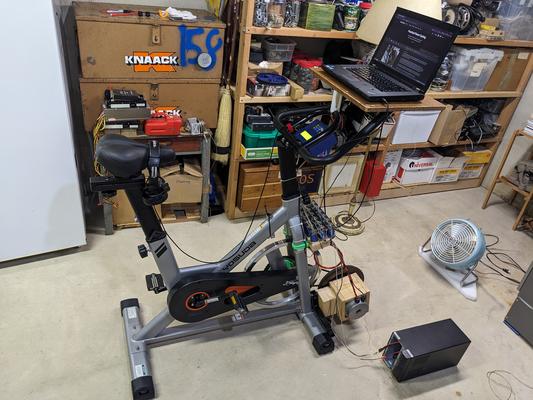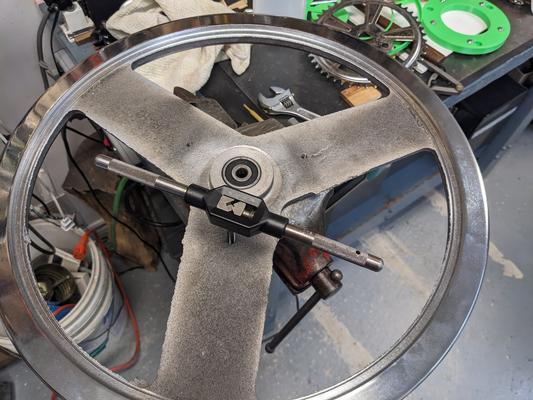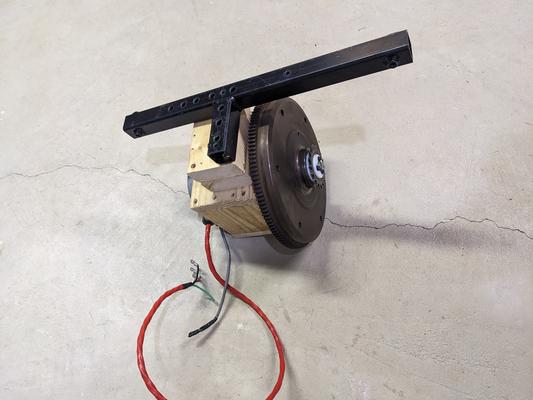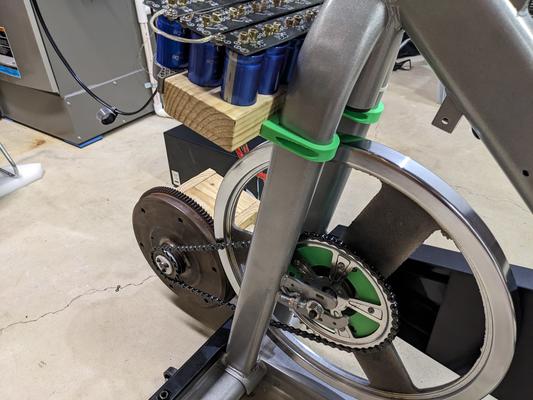
2023-07-29 07:19 | [practical-power-cycling]
previous: Unexpected turn of events - next: Another year, another 10 kWh
This is part of my bicycle generator project originally posted on hackaday.io
After last week's failure, I decided that I was really due for an upgrade. The old frame was made as cheaply as possible to begin with, and there's a good selection of decent modern frames that are a lot more robust. You can pick up one on Amazon right now and have it shipped to your house for a few hundred bucks. Or, you can go on Craigslist and pick up a used one for cheap. Since I only really cared about the frame and pedals, that's the direction I went, and picked up this specimen for $65.

After a few days, the conversion was finished. Sorry for not taking a lot of pictures, but I'll hit the highlights.

The bike seems to be the Yosuda L-001A. I don't know much about Yosuda or the stationary bike market, but it seems you can get this on Amazon for about $320. It seems to be entry-ish level from what I've seen, with a felt pad brake (now removed) instead of some kind of fancier (and quieter) magnetic version. The frame is significantly heavier duty than my old one. Also, like seemingly all of these modern bikes, it is belt driven, probably for noise reasons, as without the generator and its chain, it is dead silent. On the other hand, the belt needs to be pulled extremely tight or it will slip, and there is also no ratchet mechanism, meaning that the heavy flywheel and pedals are always locked together. This can be dangerous; if your feet slip off the pedals they will keep going and bash up your legs. This is probably why the pedals come with straps to hold onto your shoes. Since I don't like wearing shoes, I swapped out the pedals for some flat ones, and I'll take the risk. If anything bad happens I will let you know.

The supposed 35lb flywheel measures in at about 22lb on my scale, which is probably a good sign to get one of the two checked. The wheel shows no evidence of drilling for balancing, but does seem to be reasonable regardless. The front pulley is built into the casting, so I figured I would keep the flywheel for now. It is cast iron, making it very easy to drill and tap. However, it would not fit onto my drill press or lathe, so I just sort of had to eyeball it and use handheld tools. I mounted a bicycle chain sprocket rather than the thick chain I bought earlier, since the space between the wheel and frame was not as generous as the old jackshaft solution. It ended up fine; bike chain is rather forgiving. I doubt I would have been able to setup a good, concentric pulley setup here. The chain is, of course, much nosier than the belt, but since I operate this in the basement and always wear headphones, it's acceptable.

The generator similarly had to be relocated, and new shaft adapters made to connect a bicycle chain sprocket. Initially, I had hoped to eliminate the VW flywheel (after all, I kept the original bike flywheel) but I quickly realized why it is so important. The first test run without the VW flywheel was very noisy, with massive vibrations running through the frame and into the pedals. It felt like riding on a very bumpy road, or highway rumble strips. What this was is motor pole noise; as the armature moves between poles the torque required is less. This vibration travels up the chain like a string can telephone and vibrates the whole frame. I had to add some wood blocks to get enough space to add the flywheel back. The wood blocks are pretty inaccurate as far as lining things up, but it is very easy to adjust and modify.

The capacitors and gauge cluster were added in with new mounts wherever they would fit, in similar locations to the original. The one new change I made was to add a shelf for my laptop on top of the extra long handlebars. I made a pair of 3D printed expanding collets to fit in the end of the tubes which would accept a bolt, which was then bolted to a bracket to hold the shelf. Finally, I added a stabilizer at the front of the shelf to stop it flexing when I rested my hand on top to operate the mouse or keyboard. The laptop is too far away to operate comfortably while cycling, but I'd good for watching videos, and far better than the stack of boxes I used to use to hold the laptop, which was slightly off to the side. It's going to be a much better experience looking straight ahead instead of off to one side, too.

In line with the move to belt drive, the new bike chain to the generator allowed me to upgrade the gear ratio from about 6:1 to about 8:1, which is something I had been wanting to do for a while. It was taking a little too high speed to comfortably keep the 120V inverter running at a good voltage.